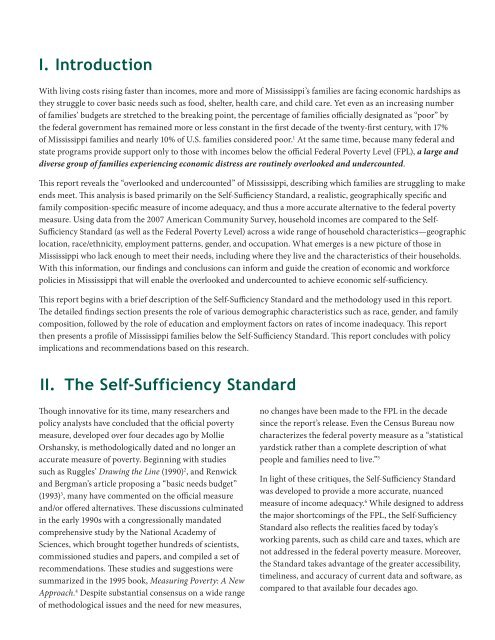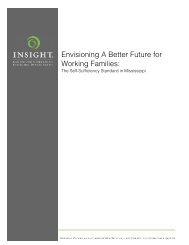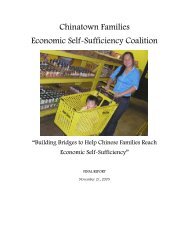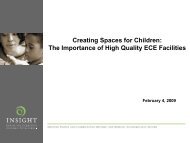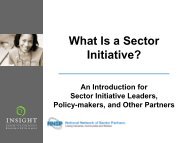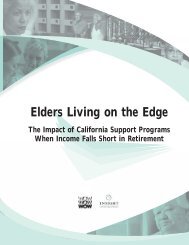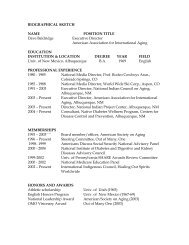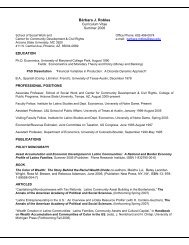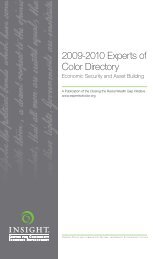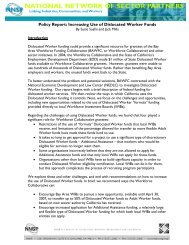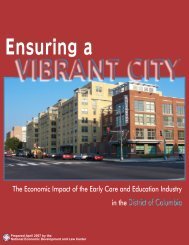Overlooked and Undercounted - Insight Center for Community ...
Overlooked and Undercounted - Insight Center for Community ...
Overlooked and Undercounted - Insight Center for Community ...
Create successful ePaper yourself
Turn your PDF publications into a flip-book with our unique Google optimized e-Paper software.
I. Introduction<br />
With living costs rising faster than incomes, more <strong>and</strong> more of Mississippi’s families are facing economic hardships as<br />
they struggle to cover basic needs such as food, shelter, health care, <strong>and</strong> child care. Yet even as an increasing number<br />
of families’ budgets are stretched to the breaking point, the percentage of families officially designated as “poor” by<br />
the federal government has remained more or less constant in the first decade of the twenty-first century, with 17%<br />
of Mississippi families <strong>and</strong> nearly 10% of U.S. families considered poor. 1 At the same time, because many federal <strong>and</strong><br />
state programs provide support only to those with incomes below the official Federal Poverty Level (FPL), a large <strong>and</strong><br />
diverse group of families experiencing economic distress are routinely overlooked <strong>and</strong> undercounted.<br />
This report reveals the “overlooked <strong>and</strong> undercounted” of Mississippi, describing which families are struggling to make<br />
ends meet. This analysis is based primarily on the Self-Sufficiency St<strong>and</strong>ard, a realistic, geographically specific <strong>and</strong><br />
family composition-specific measure of income adequacy, <strong>and</strong> thus a more accurate alternative to the federal poverty<br />
measure. Using data from the 2007 American <strong>Community</strong> Survey, household incomes are compared to the Self-<br />
Sufficiency St<strong>and</strong>ard (as well as the Federal Poverty Level) across a wide range of household characteristics—geographic<br />
location, race/ethnicity, employment patterns, gender, <strong>and</strong> occupation. What emerges is a new picture of those in<br />
Mississippi who lack enough to meet their needs, including where they live <strong>and</strong> the characteristics of their households.<br />
With this in<strong>for</strong>mation, our findings <strong>and</strong> conclusions can in<strong>for</strong>m <strong>and</strong> guide the creation of economic <strong>and</strong> work<strong>for</strong>ce<br />
policies in Mississippi that will enable the overlooked <strong>and</strong> undercounted to achieve economic self-sufficiency.<br />
This report begins with a brief description of the Self-Sufficiency St<strong>and</strong>ard <strong>and</strong> the methodology used in this report.<br />
The detailed findings section presents the role of various demographic characteristics such as race, gender, <strong>and</strong> family<br />
composition, followed by the role of education <strong>and</strong> employment factors on rates of income inadequacy. This report<br />
then presents a profile of Mississippi families below the Self-Sufficiency St<strong>and</strong>ard. This report concludes with policy<br />
implications <strong>and</strong> recommendations based on this research.<br />
II. The Self-Sufficiency St<strong>and</strong>ard<br />
Though innovative <strong>for</strong> its time, many researchers <strong>and</strong><br />
policy analysts have concluded that the official poverty<br />
measure, developed over four decades ago by Mollie<br />
Orshansky, is methodologically dated <strong>and</strong> no longer an<br />
accurate measure of poverty. Beginning with studies<br />
such as Ruggles’ Drawing the Line (1990) 2 , <strong>and</strong> Renwick<br />
<strong>and</strong> Bergman’s article proposing a “basic needs budget”<br />
(1993) 3 , many have commented on the official measure<br />
<strong>and</strong>/or offered alternatives. These discussions culminated<br />
in the early 1990s with a congressionally m<strong>and</strong>ated<br />
comprehensive study by the National Academy of<br />
Sciences, which brought together hundreds of scientists,<br />
commissioned studies <strong>and</strong> papers, <strong>and</strong> compiled a set of<br />
recommendations. These studies <strong>and</strong> suggestions were<br />
summarized in the 1995 book, Measuring Poverty: A New<br />
Approach. 4 Despite substantial consensus on a wide range<br />
of methodological issues <strong>and</strong> the need <strong>for</strong> new measures,<br />
no changes have been made to the FPL in the decade<br />
since the report’s release. Even the Census Bureau now<br />
characterizes the federal poverty measure as a “statistical<br />
yardstick rather than a complete description of what<br />
people <strong>and</strong> families need to live.” 5<br />
In light of these critiques, the Self-Sufficiency St<strong>and</strong>ard<br />
was developed to provide a more accurate, nuanced<br />
measure of income adequacy. 6 While designed to address<br />
the major shortcomings of the FPL, the Self-Sufficiency<br />
St<strong>and</strong>ard also reflects the realities faced by today’s<br />
working parents, such as child care <strong>and</strong> taxes, which are<br />
not addressed in the federal poverty measure. Moreover,<br />
the St<strong>and</strong>ard takes advantage of the greater accessibility,<br />
timeliness, <strong>and</strong> accuracy of current data <strong>and</strong> software, as<br />
compared to that available four decades ago.


